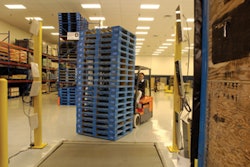Framingham, MA — April 18, 2007 — Technology cost and lack of demonstrated return on investment (ROI) are the top roadblocks contributing to slow adoption of radio frequency identification (RFID) solutions in the pharmaceutical industry, according to new industry survey by market research firm Health Industry Insights.
The survey of 143 life sciences industry leaders by Health Industry Insights, an IDC company, aimed to identify the top factors contributing to pharmaceutical industry's slow adoption of RFID.
In addition to costs and unclear ROI, the lack of an item-level frequency standard rounded out the top three reasons for slow adoption cited in the survey. Other reasons cited by respondents, in order of importance, included security/privacy concerns, lack of pressure from Federal Drug Administration and unreliable read rates (i.e., the percentage of RFID tags, or microchips attached to an antenna, that can be accurately read within a certain period of time).
Freeze on Project Funding
"While many pharmaceutical companies are eager to begin their RFID pilot work, we're seeing a freeze on project funding until an item-level frequency standard is established," said Eric Newmark, senior research analyst at Health Industry Insights. "Evaluations are being hindered by corporate fear of investing in the wrong infrastructure. It is unfortunate that patient and consumer safety is being delayed due to something this trivial."
The report goes on to spotlight the slower-than-expected RFID adoption with additional survey findings. Results reveal fewer than one in five (16 percent) pharmaceutical companies are currently evaluating the benefits of RFID technology, and even fewer (15 percent) companies are adopting RFID in some capacity.
Overall, the report indicates average life science company spend on RFID technology is approximately $25,000, although this level is expected to triple to $75,000 over the next 12 months.
Three to Six Sigma Performance
Additionally, the report discusses read rate results from commercial RFID pilots in the pharmaceutical industry. The report reveals that initiatives utilizing high-frequency (HF) technology for item-level tagging are achieving better read rates than those using ultra-high frequency (UHF).
Findings show initiatives using HF are experiencing read rates in the Four to Six Sigma range, and exceeding Six Sigma in some cases, whereas those using UHF are typically between Three and Four Sigma. (The Sigma ratings refer to the well-known management practice used to help companies achieve exceptional performance levels.)
Added Newmark: "Although we're seeing higher item-level read rates from HF technology, it's unlikely that we'll see an industry mandate for an item-level frequency. Manufacturers need to realize there is minimal risk and move forward by choosing whichever frequency they believe will deliver the best results for their situation."
Newmark's report, which also delves in to decision criteria surrounding RFID implementation and more, is entitled "Item-Level Tagging: Moving beyond the Frequency Dilemma" and is available through the Health Industry Insights Web site.
This Health Industry Insights' survey was conducted in March 2007 among 143 leaders in the life sciences industry to capture quantitative information on the topic of RFID. Findings were also complemented in the report by direct interviews used to capture more qualitative industry sentiment.
The survey of 143 life sciences industry leaders by Health Industry Insights, an IDC company, aimed to identify the top factors contributing to pharmaceutical industry's slow adoption of RFID.
In addition to costs and unclear ROI, the lack of an item-level frequency standard rounded out the top three reasons for slow adoption cited in the survey. Other reasons cited by respondents, in order of importance, included security/privacy concerns, lack of pressure from Federal Drug Administration and unreliable read rates (i.e., the percentage of RFID tags, or microchips attached to an antenna, that can be accurately read within a certain period of time).
Freeze on Project Funding
"While many pharmaceutical companies are eager to begin their RFID pilot work, we're seeing a freeze on project funding until an item-level frequency standard is established," said Eric Newmark, senior research analyst at Health Industry Insights. "Evaluations are being hindered by corporate fear of investing in the wrong infrastructure. It is unfortunate that patient and consumer safety is being delayed due to something this trivial."
The report goes on to spotlight the slower-than-expected RFID adoption with additional survey findings. Results reveal fewer than one in five (16 percent) pharmaceutical companies are currently evaluating the benefits of RFID technology, and even fewer (15 percent) companies are adopting RFID in some capacity.
Overall, the report indicates average life science company spend on RFID technology is approximately $25,000, although this level is expected to triple to $75,000 over the next 12 months.
Three to Six Sigma Performance
Additionally, the report discusses read rate results from commercial RFID pilots in the pharmaceutical industry. The report reveals that initiatives utilizing high-frequency (HF) technology for item-level tagging are achieving better read rates than those using ultra-high frequency (UHF).
Findings show initiatives using HF are experiencing read rates in the Four to Six Sigma range, and exceeding Six Sigma in some cases, whereas those using UHF are typically between Three and Four Sigma. (The Sigma ratings refer to the well-known management practice used to help companies achieve exceptional performance levels.)
Added Newmark: "Although we're seeing higher item-level read rates from HF technology, it's unlikely that we'll see an industry mandate for an item-level frequency. Manufacturers need to realize there is minimal risk and move forward by choosing whichever frequency they believe will deliver the best results for their situation."
Newmark's report, which also delves in to decision criteria surrounding RFID implementation and more, is entitled "Item-Level Tagging: Moving beyond the Frequency Dilemma" and is available through the Health Industry Insights Web site.
This Health Industry Insights' survey was conducted in March 2007 among 143 leaders in the life sciences industry to capture quantitative information on the topic of RFID. Findings were also complemented in the report by direct interviews used to capture more qualitative industry sentiment.










